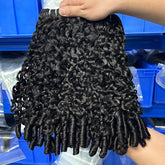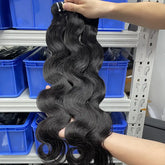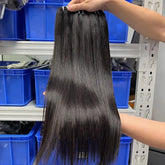How to Recognize Good Lace and Bad Lace: A Stylist’s Guide
In the world of wig making, lace is the unsung hero that can make or break the final product. As a delicate fabric where individual hair strands are tied to mimic a natural scalp, the quality of lace directly impacts the realism, durability, and comfort of a wig. For stylists and B2B buyers in the human hair and wigs market, knowing how to distinguish good lace from bad lace is essential to delivering top-tier products that satisfy clients and enhance your business reputation. In this step-by-step guide, we’ll explore how to evaluate lace quality, offering practical tips and real-world examples tailored to business professionals in the wig manufacturing industry
What is Lace in Wigs?
Lace is a delicate, mesh-like material used in wig construction. You’ll typically find it at the front (in lace front wigs) or across the entire cap (in full lace wigs). Its job? To blend invisibly with the wearer’s skin, mimicking a natural hairline. When done right, it’s like the hair is growing straight from the scalp. But when the lace is poor quality, it can ruin the whole effect.
Why Lace Quality Matters
The quality of lace impacts everything:
Appearance: Good lace looks natural; bad lace screams “wig.”
Comfort: High-quality lace feels good for all-day wear; low-quality lace can irritate.
Durability: Good lace lasts; bad lace tears or frays quickly.
For stylists and B2B buyers, choosing high-quality lace wigs isn’t just about aesthetics—it’s about client satisfaction and business success.
Step-by-Step Guide to Recognizing Good and Bad Lace
Here’s how I assess lace quality in my work. Follow these six steps to ensure you’re picking the best for your clients or inventory:
Step 1: Examine the Material
Good Lace: Soft, fine, and silky to the touch. Think Swiss lace or French lace—premium materials known for their natural look and strength.
Bad Lace: Rough, coarse, or stiff. Often made from cheap synthetics that feel artificial.
Tip: Rub the lace between your fingers. If it’s smooth and barely noticeable, it’s a winner. If it feels like stiff netting, pass.
Step 2: Check the Color
Good Lace: Available in multiple shades or transparent (like HD lace) to match any skin tone seamlessly.
Bad Lace: Stuck in one mismatched color, making the hairline obvious.
Example: I once styled a client with a warm medium-brown complexion. The lace on her wig matched perfectly, blending right in. A poorly matched lace would’ve stood out like a sore thumb.
Step 3: Test the Durability
Good Lace: Tough yet flexible—handles gentle tugging without tearing and springs back into shape.
Bad Lace: Fragile, especially at the edges, and prone to ripping.
Tip: Give the lace a light pull. If it holds up without stretching too far or tearing, it’s solid. If it feels flimsy, it won’t last.
Step 4: Assess Breathability
Good Lace: Lets air flow to keep the scalp cool and comfy.
Bad Lace: Thick or non-breathable, trapping heat and sweat.
Real-World Example: A client of mine wears her wig daily for work. With breathable lace, she stays comfortable all day. I’ve seen cheaper wigs cause irritation because the scalp couldn’t breathe.
Step 5: Inspect the Hair Attachment
Good Lace: Hand-tied hair with tiny, invisible single knots for that “growing from the scalp” look.
Bad Lace: Machine-sewn wefts that look bulky and fake.
Tip: Check the hairline up close. If the knots are small and mimic natural growth, it’s hand-tied quality. Big, clumpy knots? It’s a no-go.
Step 6: Consider Maintenance
Good Lace: Easy to care for—minimal shedding or tangling with basic wig maintenance.
Bad Lace: High-maintenance, sheds like crazy, or falls apart fast.
Tip: Ask about care instructions. Good lace should handle gentle shampooing without issues. If it sounds like a hassle, it’s probably low-quality.
Real-World Examples
Here’s how recognizing good versus bad lace plays out in practice:
Case Study 1: A stylist used a low-quality lace wig that was thick and opaque, resulting in an unnatural hairline that disappointed the client. Switching to Swiss lace solved the issue, delivering a seamless look that won rave reviews.
Case Study 2: A manufacturer faced returns due to lace tearing during styling. Investigation revealed inconsistent thickness in the batch. Sourcing uniform, durable lace eliminated the problem and boosted customer trust.
Case Study 3: A luxury salon invested in HD lace for their high-end wigs. Though pricier, the ultra-natural finish and comfort led to glowing feedback, higher sales, and a stronger brand reputation.
Conclusion
Spotting the difference between good lace and bad lace is a game-changer for anyone in the human hair/wigs market. Use this guide to evaluate lace like a pro—your clients will thank you with their loyalty, and your business will thrive. High-quality lace isn’t just about looks; it’s about delivering value that lasts.
Need top-tier human hair lace wigs for your salon or bulk orders? Reach out—I’d love to help you find the best.







